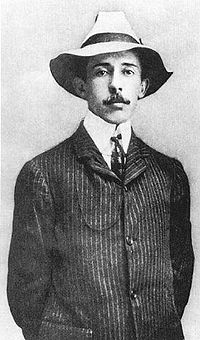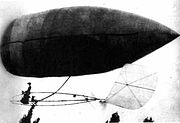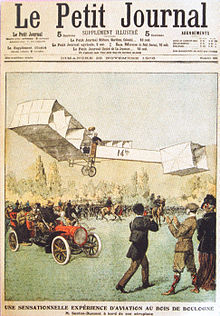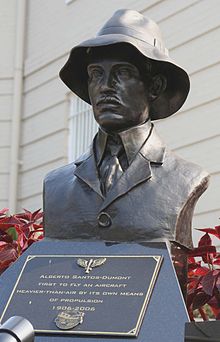
Alberto Santos-Dumont
Background Information
Arranging a Wikipedia selection for schools in the developing world without internet was an initiative by SOS Children. A good way to help other children is by sponsoring a child
| Alberto Santos-Dumont | |
|---|---|
 |
|
| Born | 20 July 1873 Palmira, Minas Gerais, Empire of Brazil |
| Died | 23 July 1932 (aged 59) Guarujá, São Paulo, Brazil |
| Occupation | Aviator, inventor |
| Signature | |
Alberto Santos-Dumont (Portuguese pronunciation: [ɐwˈbɛʁtu ˈsɐ̃tuz duˈmõ]; 20 July 1873 – 23 July 1932) was a Brazilian aviation pioneer. The heir of a wealthy family of coffee producers, Santos Dumont dedicated himself to aeronautical study and experimentation in Paris, France, where he spent most of his adult life.
Santos-Dumont designed, built, and flew the first practical dirigible, demonstrating that routine, controlled flight was possible. This "conquest of the air", in particular his winning the Deutsch de la Meurthe prize on 19 October 1901 on a flight that rounded the Eiffel Tower, made him one of the most famous people in the world during the early 20th century.
On 23 October 1906, in addition to his pioneering work in airships, Santos-Dumont flew an fixed-wing aircraft of his own design and construction, the 14-bis or "oiseau de proie" (French for "bird of prey"), the first heavier-than-air flight to be certified by the Aéro Club de France and the Fédération Aéronautique Internationale (FAI).
In his homeland, Brazil, Santos-Dumont is considered a national hero and the father of aviation, having his name written in Brazilian Hero Panthéon.
Santos-Dumont occupied the 38th chair of the Brazilian Academy of Letters, from 1931 until his death in 1932.
Biography
Childhood
Santos-Dumont was born in Cabangu Farm, a farm in the Brazilian town of Palmira, today named Santos Dumont in the state of Minas Gerais, in the Southeast Brazil. He grew up as the sixth of eight children on a coffee plantation owned by his family in the state of São Paulo. His French-born father was an engineer, and made extensive use of the latest labor-saving inventions on his vast property. So successful were these innovations that Santos-Dumont's father gathered a large fortune and became known as the "Coffee King of Brazil."
Santos-Dumont was fascinated by machinery, and while still a young child he learned to drive the steam tractors and locomotive used on his family's plantation. He was also a fan of Jules Verne and had read all his books before his 10th birthday. Santos-Dumont wrote in his autobiography that the dream of flying came to him while contemplating the magnificent skies of Brazil in the long, sunny afternoons at the plantation.
According to the custom of wealthy families of the time, after receiving basic instruction at home with private instructors including his parents, young Alberto was sent out alone to larger cities to do his secondary studies. Santos-Dumont studied for a while in " Colégio Culto à Ciência", in Campinas.
Move to France
In 1891, Alberto's father had an accident while inspecting some machinery. He fell from his horse and became a paraplegic. He decided to sell the plantation and move to Europe with his wife and younger children. At 17, Santos-Dumont left the prestigious Escola de Minas in Ouro Preto, Minas Gerais, for Paris. Shortly after he arrived, Santos-Dumont bought an automobile. Later, he pursued studies in physics, chemistry, mechanics, and electricity with the help of a private tutor.
Balloons and dirigibles
Santos-Dumont described himself as the first "sportsman of the air." He started flying by hiring an experienced balloon pilot and took his first balloon rides as a passenger. He quickly moved on to piloting balloons himself, and shortly thereafter to designing his own balloons. In 1898, Santos-Dumont flew his first balloon design, the Brésil.
After numerous balloon flights, Santos-Dumont turned to the design of steerable balloons, or dirigible, that could be propelled through the air rather than drifting along with the wind. A dirigible, La France, capable of flying at around 24 km/h (15 mph) had been successfully flown in 1884 by Charles Renard and Arthur Krebs, but their experiments had not progressed due to a lack of funding. Between 1898 and 1905, Santos-Dumont built and flew 11 dirigibles. With air traffic control restrictions still decades in the future, he would float along Paris boulevards at rooftop level in one of his airships, commonly landing in front of a fashionable outdoor cafe for lunch. On one occasion, Santos-Dumont even flew an airship early one morning to his own apartment at No. 9, Rue Washington, just off Avenue des Champs-Élysées, not far from the Arc de Triomphe.
To win the Deutsch de la Meurthe prize Santos-Dumont decided to build a bigger craft, the dirigible Number 5. On 8 August 1901, during one of his attempts, his dirigible lost hydrogen gas. It started to descend and was unable to clear the roof of the Trocadero Hotel. A loud explosion was then heard. Santos-Dumont survived the explosion and was left hanging in a basket from the side of the hotel. With the help of the crowd, he climbed to the roof without injury.
The zenith of his lighter-than-air career came when Santos-Dumont won the Deutsch de la Meurthe prize. This was for the first flight from the Parc Saint Cloud to the Eiffel Tower and back in less than 30 minutes, necessitating an average ground speed of at least 22 km/h (14 mph) to cover the round trip distance of 11 km (6.8 mi) in the allotted time.
On 19 October 1901, after several attempts, Santos-Dumont succeeded in making the trip in using his dirigible Number 6. Immediately after the flight, a controversy broke out around a last minute rule change regarding the precise timing of the flight. There was much public outcry and comment in the press. Finally, after several days of vacillating by the committee of officials, Santos-Dumont was awarded the prize as well as the prize money of 125,000 francs. In a charitable gesture, Santos-Dumont donated 75,000 francs of the prize money to the poor of Paris. The balance was given to his workmen as a bonus. An additional matching 125,000 francs was voted to him along with a gold medal by the government of his native Brazil.
Santos-Dumont's aviation feats made him a celebrity in Europe and throughout the world. He won several more prizes and became a friend to millionaires, aviation pioneers, and royalty. In 1903 Aida de Acosta piloted Santos-Dumont's airship. In 1904, he went to the United States and was invited to the White House to meet U.S. President Theodore Roosevelt.
In 1904, Santos-Dumont shipped his new airship No. 7 (also called Racer), from Paris to St. Louis to fly at the Louisiana Purchase Exposition, to compete for the Grand Prize of $100,000 which was to be given to a flying machine (of any sort) that could make three round-trip flights over a 24 km (15 mile) “L”-shaped course at an overall average speed of 32 kph (20 mph),later reduced to 24 kph (15 mph). It was also necessary for the machine to land without damage to craft or crew not more than 46 m (150 ft) from the starting point. Because he was probably the best-known aviator at the time, the Fair committee went to great lengths to ensure his participation, including modifying the rules. However, upon arrival in St. Louis, Santos-Dumont found his airship’s gas bag to be irreparably damaged. Sabotage, although suspected, was never proven, and Santos-Dumont did not participate in the contest after suspicion of the deed, a repeat of a similar incident in Boston, began to focus somewhat absurdly on Santos- Dumont himself. He indignantly left the Fair and returned immediately to France.
The public eagerly followed his daring exploits. Parisians affectionately dubbed Santos-Dumont le petit Santos. The fashionable folk of the day mimicked various aspects of his style of dress, from his high collared shirts to his signature Panama hat. He was, and remains to this day, a prominent folk hero in his native Brazil.
Heavier than air aircraft
Although Santos-Dumont continued to work on dirigibles, his primary interest soon turned to heavier-than-air aircraft. By 1905, he had finished his first fixed-wing aircraft design, and also a helicopter. Santos-Dumont finally achieved his dream of flying an aircraft on 23 October 1906 by piloting the 14-bis before a large crowd of witnesses for a distance of 60 metres (197 ft) at a height of about five meters or less (15 ft). This well-documented event was the first flight verified by the Aéro-Club de France of a powered heavier-than-air machine in Europe and won the Deutsch-Archdeacon Price for the first officially observed flight further than 25 meters. On 12 November 1906, Santos-Dumont set the first world record recognized by the Federation Aeronautique Internationale by flying 220 metres in 21.5 seconds.
Santos-Dumont made other contributions to the field of aircraft design. He added movable surfaces, the precursor to ailerons, between the wings in an effort to gain more lateral stability than was offered by the 14-bis wing dihedral. He also pushed for and exploited substantial improvements in engine power-to-weight ratio, and other refinements in aircraft construction techniques.
Santos-Dumont's final design were the Demoiselle monoplanes (Nos. 19 to 22). These aircraft were used by Dumont for personal transport. The fuselage consisted of three specially reinforced bamboo booms, and the pilot sat a seat between the main wheels of a tricycle landing gear. The Demoiselle was controlled in flight by a tail unit that functioned both as elevator and rudder, and by wing warping (No. 20).
In 1908, Santos-Dumont started working with Adolphe Clément's Clement-Bayard company to mass-produce the Demoiselle No 19. They planned a production run of 100 units, built 50 but sold only 15, for 7,500 francs for each airframe. It was the world's first series production aircraft. By 1909 it was offered with a choice of three engines: Clement 20 hp; Wright 4-cyl 30 hp (Clement-Bayard had the license to manufacture Wright engines) and Clement-Bayard 40 hp designed by Pierre Clerget. The Demoiselle could achieve a speed of120 km/h.
The Demoiselle could be constructed in only 15 days. Possessing a good performance, flying at a speed of more than 100 km/h, the Demoiselle was the last aircraft designed by Santos-Dumont. The June 1910 edition of the Popular Mechanics magazine published drawings of the Demoiselle and stated, "This machine is better than any other which has ever been built, for those who wish to reach results with the least possible expense and with a minimum of experimenting." American companies sold drawings and parts for Demoiselles for several years afterward. Santos-Dumont was so enthusiastic about aviation that he made the drawings of the Demoiselle available free of charge, thinking that aviation would lead to a new prosperous era for mankind.
The first fixed-wing aircraft: The 14-bis versus the Wright Flyers
Mainstream aviation historians credit the Wright Brothers with the creation of the first successful heavier-than-air flying machine, able to take off under its own power and capable of sustained and controlled flight.
The Wrights used a launching rail for their 1903 flights and a launch catapult for their 1904 and 1905 machines, while the aircraft of Santos-Dumont and other Europeans had wheeled undercarriages. The Wright Brothers continued to use skids, which necessitated the use of a dolly running on a track. The Fédération Aéronautique Internationale, founded in France in 1905 to verify aviation records, stated among its rules that an aircraft should be able to take off under its own power in order to qualify for a record. Supporters of Santos-Dumont maintain that this means the 14-bis was, technically, the first successful fixed-wing aircraft.
The issue of which aircraft was first or more practical is a matter of debate between supporters of Santos-Dumont and the Wright brothers. The Wrights flew earlier, and Santos-Dumont took off on wheels before the Wrights, earning a variety of prizes and official records in France. Santos-Dumont's flights in the 14-bis contributed to the development of aviation by publicly demonstrating the feasibility of heavier-than-air flight, which encouraged other pioneers in Europe to begin or quicken the pace of their experiments.
Wristwatch
When travelling in the Demoiselle, Santos-Dumont needed to measure the time interval. The wristwatch had already been invented by Patek Philippe, decades earlier, but Santos-Dumont played an important role in popularizing its use by men in the early 20th century. Before him they were generally worn only by women (as jewels), as men favoured pocket watches.
In 1904, while celebrating his winning of the Deutsch Prize at Maxim's Restaurant in Paris, Santos-Dumont complained to his friend Louis Cartier about the difficulty of checking his pocket watch to time his performance during flight. Santos-Dumont then asked Cartier to come up with an alternative that would allow him to keep both hands on the controls. Cartier went to work on the problem and the result was a watch with a leather band and a small buckle, to be worn on the wrist.
Santos-Dumont never took off again without his personal Cartier wristwatch, and he used it to check his personal record for a 220 m (730 ft) flight, achieved in 21 seconds, on 12 November 1906. The Santos-Dumont watch was officially displayed on 20 October 1979 at the Paris Air Museum next to the 1908 Demoiselle, the last aircraft that he built.
Cartier market wristwatches and sunglasses named after Santos-Dumont.
Later years
Santos-Dumont bought one of the very early Le Zèbre cars, now on display at the São Paulo car museum.
Santos-Dumont continued to build and fly airplanes, such as the N21 Demoiselle. His final flight as a pilot was made in Demoiselle on 4 January 1910. The flight ended in an accident, but the cause was never completely clear. There were few observers and no reporters on the scene. However, in a PBS documentary about Santos-Dumont it is alleged that the crash was due to a snapped wire.
Santos-Dumont fell seriously ill a few months later. He experienced double vision and vertigo that made it impossible for him to drive, much less fly. He was diagnosed with multiple sclerosis. He abruptly dismissed his staff and closed his workshop. His illness soon led to a deepening depression.
In 1911, Santos-Dumont moved from Paris to the French seaside village of Bénerville (now Benerville-sur-Mer) where he took up astronomy as a hobby. Some of the local folk, who knew little of his great fame and exploits in Paris just a few years earlier, mistook his German-made telescope and unusual accent as signs that he was a German spy who was tracking French naval activity. These suspicions eventually led to Santos-Dumont having his rooms searched by the French military police. Upset by the charge, as well as depressed from his illness, Santos-Dumont burned all of his papers, plans and notes. Thus, there is little direct information available about his designs today.
In 1931, Santos-Dumont left France to go back to his country of birth. His return to Brazil was marred by tragedy. A dozen members of the Brazilian scientific community boarded a seaplane with the intention of paying a flying welcome to the returning aviator on the luxury liner Cap Arcona. The seaplane, however, crashed with the loss of all on board. The loss deepened Santos-Dumont's growing despondency.
In Brazil, Santos-Dumont bought a small lot on the side of a hill in the city of Petrópolis, in the mountains near Rio de Janeiro, and in 1918 built a small house there filled with imaginative mechanical gadgetry including an alcohol-fueled heated shower of his own design. The hill was purposefully chosen because of its great steepness as a proof that ingenuity could make it possible to build a comfortable house in that unlikely site. After building it, he used to spend his summers there to escape the heat in Rio, and affectionately called it A Encantada (The Enchanted), after its street, Rua do Encanto (Enchantment Street). The house has its stairs designed in a curious way, each tread alternately hollowed in the right and left, like an alternating tread stair: it allows that the stairs be steep enough to fit the little room available in the house, but still enable people to climb it comfortably. As the first hollow was in the left side of the stairs, people must step first with their right foot to climb it.
Private life
Santos-Dumont, a lifelong bachelor, did seem to have a particular affection for a married Cuban-American woman named Aída de Acosta. She is the only other person that he ever permitted to fly one of his airships. By allowing her to fly his No. 9 airship she most likely became the first woman to pilot a powered aircraft. Until the end of his life, he kept a picture of her on his desk alongside a vase of fresh flowers. Nonetheless, there is no indication that Santos-Dumont and Acosta stayed in touch after her flight. Upon Santos-Dumont's death, Acosta was reported as saying that she hardly knew the man.
Santos-Dumont is also known to not only have often used an equal sign (=) between his two surnames in place of a hyphen, but also seems to have preferred that practice, to display equal respect for his father's French ethnicity and the Brazilian ethnicity of his mother.
Death
Santos-Dumont – seriously ill, and said to be depressed over his multiple sclerosis (not confirmed) and the use of aircraft in warfare during São Paulo's Constitutionalist Revolution, on 23 July 1932, committed suicide by hanging himself in the city of Guarujá in São Paulo. However, his mysterious death in circumstances not totally explainable, provides sound elements to question if he was not murdered instead.
Santos-Dumont was buried in the Cemitério São João Batista in Rio de Janeiro. There are many monuments commemorating him in the country of his birth and elsewhere. His house in Petrópolis, Brazil is now a museum. In 1997, the U.S. President Bill Clinton referred to Santos-Dumont as the father of aviation, as a clear form of recognizing the importance and paramount contribution of his work to the aviation industry and history of aircraft.
Legacy
- Santos Dumont is a small lunar impact crater that lies in the northern end of the Montes Apenninus range at the eastern edge of the Mare Imbrium
- The aviator gives his name to the city of Santos Dumont, in the state of Minas Gerais, Brazil. In this municipality is located the Cabangu farm, where he was born. The Faculdades Santos Dumont is a group of private higher learning colleges in the city.
- The city of Dumont, in the state of São Paulo, near Ribeirão Preto is so named because it is located where it used to be one the largest coffee farms in the world, between 1870 and 1890. The farm was owned by Alberto Santos-Dumont's father. It was sold in 1896 to a British company, the Dumont Coffee Company.
- Airports in Rio de Janeiro (see Santos Dumont Airport) and Paranaguá (see Paranaguá Airport) are named after him.
- The Rodovia Santos Dumont is a highway in the state of São Paulo.
- The Brazilian Air Force (Command of Aeronautics) awards the Santos Dumont Medal of Merit to important personalities in the world of aviation. The state government of Minas Gerais has a similar medal.
- The Réseau Santos Dumont is a cooperative university network between France and Brazil, instituted by the French and Brazilian Ministries of Education in 1994, with 26 universities in each country.
- The American Office of Naval Research of San Diego, California named one of its research airships as the 600B Santos Dumont.
- The Historic and Cultural Institute of Aeronautics of Brazil has instituted the Santos Dumont Annual Prize of Journalism to the best reports in the media about aeronautics.
- The Lycée Polyvalent Santos Dumont is a lyceum in Saint-Cloud, France
- Tens of thousands of streets, avenues, plazas, schools, monuments, etc., are dedicated to the national hero in Brazil.
- Santos-Dumont is mentioned as a pioneer of aviation, specifically in the area of dirigibles, in the 1984 novel by Robert A. Heinlein entitled Job: A Comedy of Justice.
- The official Brazilian Presidential Aircraft, an Airbus Corporate Jet tail number FAB2101, was named Alberto Santos Dumont.
- A popular Chilean rock band of the 1990s adopted the name Santos Dumont.
- A short story by H.G. Wells, "The Truth About Pyecraft", includes a reference to Santos-Dumont and his skill as an aviator.
- The aviator gives his name to a boutique Aircraft Management and Consultancy Company, Santos Dumont, founded in May 2004.
- The first Brazilian astronaut Marcos Pontes space flight to International Space Station (ISS) was part of 100th Anniversary commemoration of his 14bis flight. AEB (Brazilian Space Agency) codenamed Pontes' flight on Soyuz TMA-8 and further return on Soyuz TMA-7 Missão Centenário (Mission Century), as a homage.












